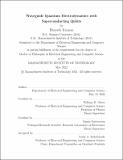| dc.description.abstract | Experiments utilizing quantum optics have progressed rapidly in last few decades, particularly in the context of quantum computation, simulation, and communication. Early work in this field focused on implementations of cavity quantum electrodynamics (QED), where atoms, either natural or artificial, are strongly coupled to the confined photonic modes of cavities. However, in recent years, achieving strong coupling between atoms and itinerant photons has also gained significant interest for its applications in quantum networking. To this end, many atomic platforms are attempting to realize the waveguide QED architecture: atoms that interact with the continua of propagating photonic modes within a waveguide.
In this thesis, we realize the strong-coupling regime of a waveguide QED architecture by coupling superconducting artificial atoms, typically operated as qubits, to one-dimensional transmission lines. We first demonstrate that superconducting qubits in a waveguide QED system can be used as high-quality quantum emitters. We then leverage the quantum interference between the simultaneous emission from multiple qubits in order to generate non-classical, spatially entangled, and directional itinerant microwave photons. These types of photons are particularly useful for remote entanglement and quantum communication protocols. Finally, we demonstrate that superconducting qubits can be engineered to enter novel regimes of light-matter interactions that are difficult, or even impossible, to achieve in other atomic platforms. In particular, we realize the giant-atom regime of waveguide QED, where the atom can no longer be treated as a point-like object. We use our giant atoms to implement tunable atom-waveguide couplings, as well as decoherence-free waveguide-mediated interactions between multiple atoms. | |
